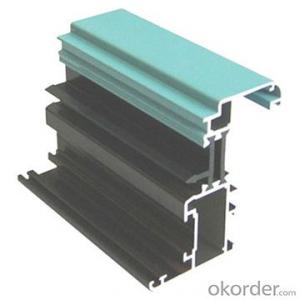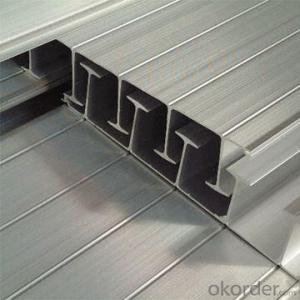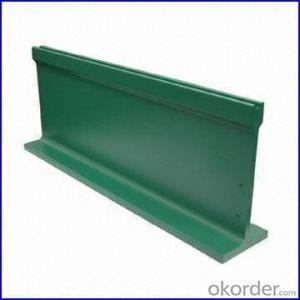all kinds of surface treatment aluminum profile for windows and doors
- Loading Port:
- China Main Port
- Payment Terms:
- TT OR LC
- Min Order Qty:
- -
- Supply Capability:
- -
OKorder Service Pledge
OKorder Financial Service
You Might Also Like
Aluminium is a relatively soft, durable, lightweight, ductileand malleablemetalwith appearance ranging from silvery to dull gray, depending on the surfaceroughness. It is nonmagnetic and does not easily ignite. A fresh film ofaluminium serves as a good reflector (approximately 92%) of visible lightand an excellent reflector (as much as 98%) of medium and far infraredradiation. The yield strength of pure aluminium is 7–11 MPa,while aluminium alloys have yield strengths ranging from200 MPa to 600 MPa. Aluminium has about one-third the densityand stiffness of steel. It is easily machined,cast, drawn and extruded.
Features:
Material | Alloy 6063,6061,6005or according to customer’s choice |
Temper | T3, T4, T5, T6 |
Surface | Anodize, electrophoresis, powder coating, PVDF coating, wood grain painting, matted, etc. |
Length | Coating 6.5 meters, Anodizing 6.5 meters, Mill finish 5 meters |
Application | Industrial, electrical equipment(TV set, air conditioner, refrigerator, computer), decoration,construction, transportation |
Custom Made | We can package following with customer's request. |
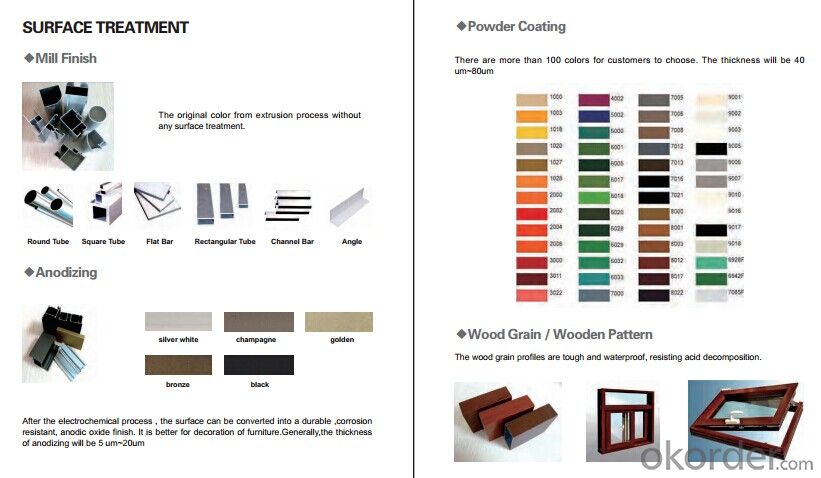

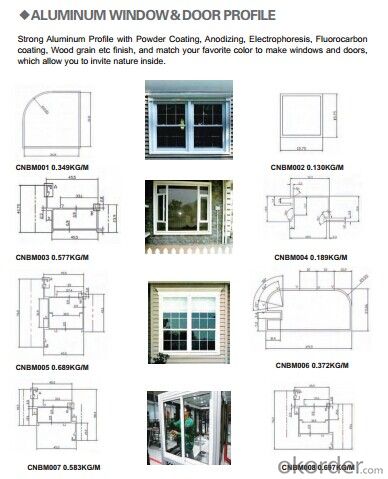
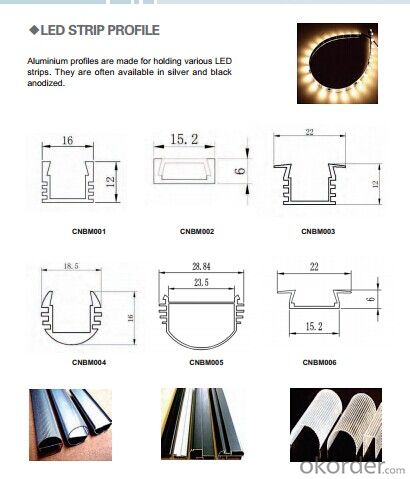
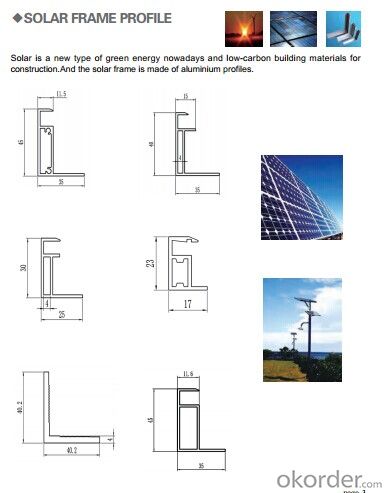
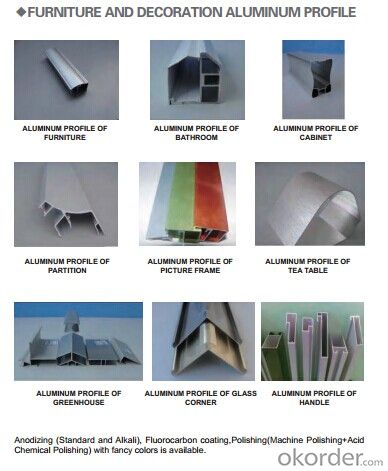
- Q:Can aluminum profiles be used in the production of agricultural machinery?
- Yes, aluminum profiles can be used in the production of agricultural machinery. Aluminum is a lightweight and durable material that can withstand harsh environmental conditions, making it suitable for various components and structures in agricultural machinery. Additionally, aluminum profiles offer flexibility in design and can be easily customized to meet specific requirements, enhancing the efficiency and performance of agricultural equipment.
- Q:Are aluminum profiles suitable for use in transportation vehicle bodies?
- Transportation vehicle bodies can benefit from the use of aluminum profiles. Aluminum is a material that is both lightweight and durable, making it suitable for this purpose. By utilizing aluminum profiles, vehicles can achieve a reduced weight, resulting in improved fuel efficiency and lower emissions. Furthermore, the excellent strength-to-weight ratio of aluminum profiles enables them to withstand the stresses and loads experienced by transportation vehicles. The corrosion resistance of aluminum is also advantageous, especially for vehicles exposed to harsh environmental conditions. Additionally, the flexibility of aluminum profiles allows for easy formation and shaping into complex designs, providing versatility in vehicle body construction. Overall, the adoption of aluminum profiles in transportation vehicle bodies presents numerous advantages, contributing to its widespread popularity in the industry.
- Q:Are aluminum profiles suitable for indoor applications with high humidity?
- Yes, aluminum profiles are suitable for indoor applications with high humidity. Aluminum is highly resistant to corrosion and does not rust, making it an ideal material for humid environments. Additionally, aluminum profiles can withstand moisture and humidity without warping or deteriorating, ensuring their durability and suitability for such conditions.
- Q:Can aluminum profiles be used for signage?
- Signage can indeed utilize aluminum profiles. Aluminum, a material known for its versatility and durability, is commonly utilized in various signage applications. It boasts numerous advantages, including its lightweight nature, resistance to corrosion, and ease of manipulation. Aluminum profiles can be effortlessly shaped into diverse forms and sizes, rendering them suitable for a vast array of signage needs. Furthermore, these profiles can be powder coated or painted to attain the desired color and finish, thereby enhancing the signage's overall appearance. Notably, aluminum is an environmentally friendly option for signage projects as it is highly recyclable, contributing to its sustainability. All in all, due to their durability, versatility, and aesthetic appeal, aluminum profiles remain a favored choice for signage projects.
- Q:Many aluminum extrusions are edge banding materials. What special advantages do they have for opening materials?.
- Most brands have more openings. For example, New River aluminum material, the United States and aluminum, Zhong Wang aluminum and so on. Obviously, the sealing material has advantages. It's more popular now.
- Q:Can aluminum profiles be used for curtain wall systems?
- Yes, aluminum profiles can be used for curtain wall systems. In fact, aluminum is one of the most commonly used materials for curtain wall construction due to its numerous advantages. Aluminum profiles offer excellent strength and durability, making them capable of supporting the weight of large glass panels. Additionally, aluminum is highly resistant to corrosion, which is essential for exterior applications where the curtain wall is exposed to various weather conditions. Moreover, aluminum profiles can be easily extruded into various shapes and sizes, allowing for design flexibility and customization. The lightweight nature of aluminum also makes it easier to handle and install, reducing labor and transportation costs. Furthermore, aluminum is a sustainable material as it is recyclable, contributing to the overall sustainability of the curtain wall system. Overall, aluminum profiles are a suitable choice for curtain wall systems due to their strength, durability, corrosion resistance, design flexibility, and sustainability.
- Q:What are the different extrusion processes used for aluminum profiles?
- There are several different extrusion processes used for aluminum profiles, including hot extrusion, cold extrusion, indirect extrusion, and direct extrusion. In hot extrusion, the aluminum is heated to a high temperature and forced through a die to create the desired profile. Cold extrusion involves forming the aluminum at room temperature using high pressure. Indirect extrusion involves pushing the aluminum billet through a stationary die, while direct extrusion involves pushing the billet through a moving die. Each process has its own advantages and is used for different applications in the manufacturing of aluminum profiles.
- Q:Are aluminum profiles suitable for railway and transportation systems?
- Yes, aluminum profiles are suitable for railway and transportation systems. They are lightweight yet strong, corrosion-resistant, and can withstand harsh weather conditions. Additionally, aluminum profiles can be easily fabricated and customized to meet specific design requirements, making them an ideal choice for various applications within railway and transportation systems.
- Q:What are the different bending radii available for aluminum profiles?
- Depending on the specific application requirements, the available bending radii for aluminum profiles can vary. However, aluminum profiles typically offer a range of bending radii options to accommodate different needs. Common bending radii for aluminum profiles include 1.5D, 2D, 3D, and 4D. In these radii, the "D" refers to the outer diameter of the profile. For instance, a 1.5D bending radius indicates that the bend radius is 1.5 times the outer diameter of the profile. The choice of bending radius depends on various factors, such as the thickness and alloy of the aluminum, the desired bending angle, and the intended application. Smaller bending radii are often employed for tighter bends or when a more compact design is necessary. Conversely, larger bending radii are suitable for gentler bends or when maintaining the structural integrity of the profile is crucial. It is important to note that the bending process can impact the mechanical properties of the aluminum profile, including its strength and stiffness. Therefore, it is crucial to carefully consider the bending radius to ensure that the profile retains its desired properties post-bending. To determine the most appropriate bending radius for a specific aluminum profile, it is advisable to seek guidance from manufacturers or experts knowledgeable in aluminum bending processes. They can offer valuable insights based on the specific requirements and limitations of the application.
- Q:What kind of equipment are needed for the production of aluminum profiles?
- The production of aluminum equipment not hundreds of several decades, from the beginning, homogeneous casting furnace, extrusion machine, anodic electrophoretic coating production line groove, powder powder production line, fluorocarbon paint production line, insulated aluminum production line, processing workshop welding riveting, stitching and other processing equipment. Plus to die do I still have, cars, milling, grinding, drilling, EDM, wire cutting, and other processing equipment. I am now in a small department work of aluminum processing company.
1. Manufacturer Overview |
|
|---|---|
| Location | |
| Year Established | |
| Annual Output Value | |
| Main Markets | |
| Company Certifications | |
2. Manufacturer Certificates |
|
|---|---|
| a) Certification Name | |
| Range | |
| Reference | |
| Validity Period | |
3. Manufacturer Capability |
|
|---|---|
| a)Trade Capacity | |
| Nearest Port | |
| Export Percentage | |
| No.of Employees in Trade Department | |
| Language Spoken: | |
| b)Factory Information | |
| Factory Size: | |
| No. of Production Lines | |
| Contract Manufacturing | |
| Product Price Range | |
Send your message to us
all kinds of surface treatment aluminum profile for windows and doors
- Loading Port:
- China Main Port
- Payment Terms:
- TT OR LC
- Min Order Qty:
- -
- Supply Capability:
- -
OKorder Service Pledge
OKorder Financial Service
Similar products
New products
Hot products
Related keywords
